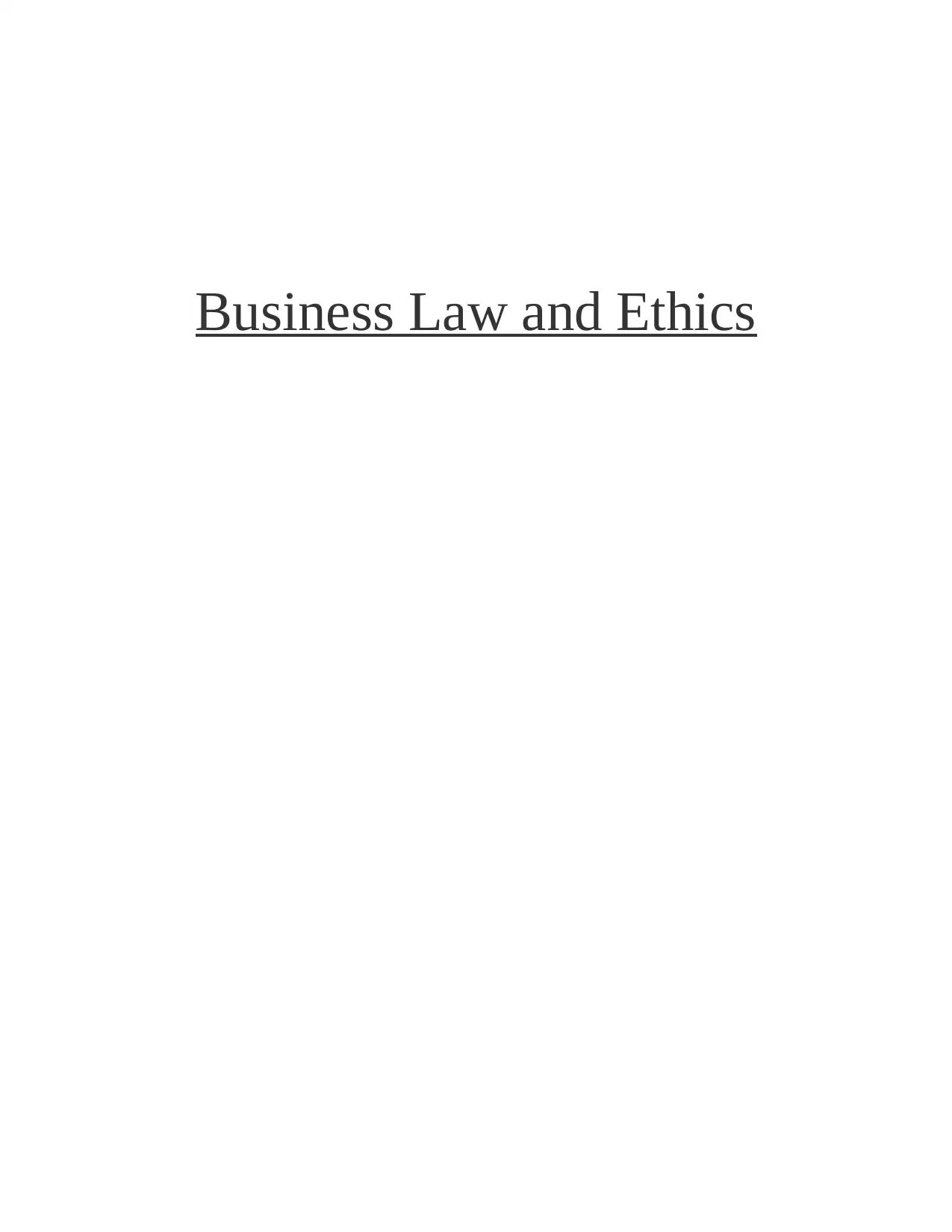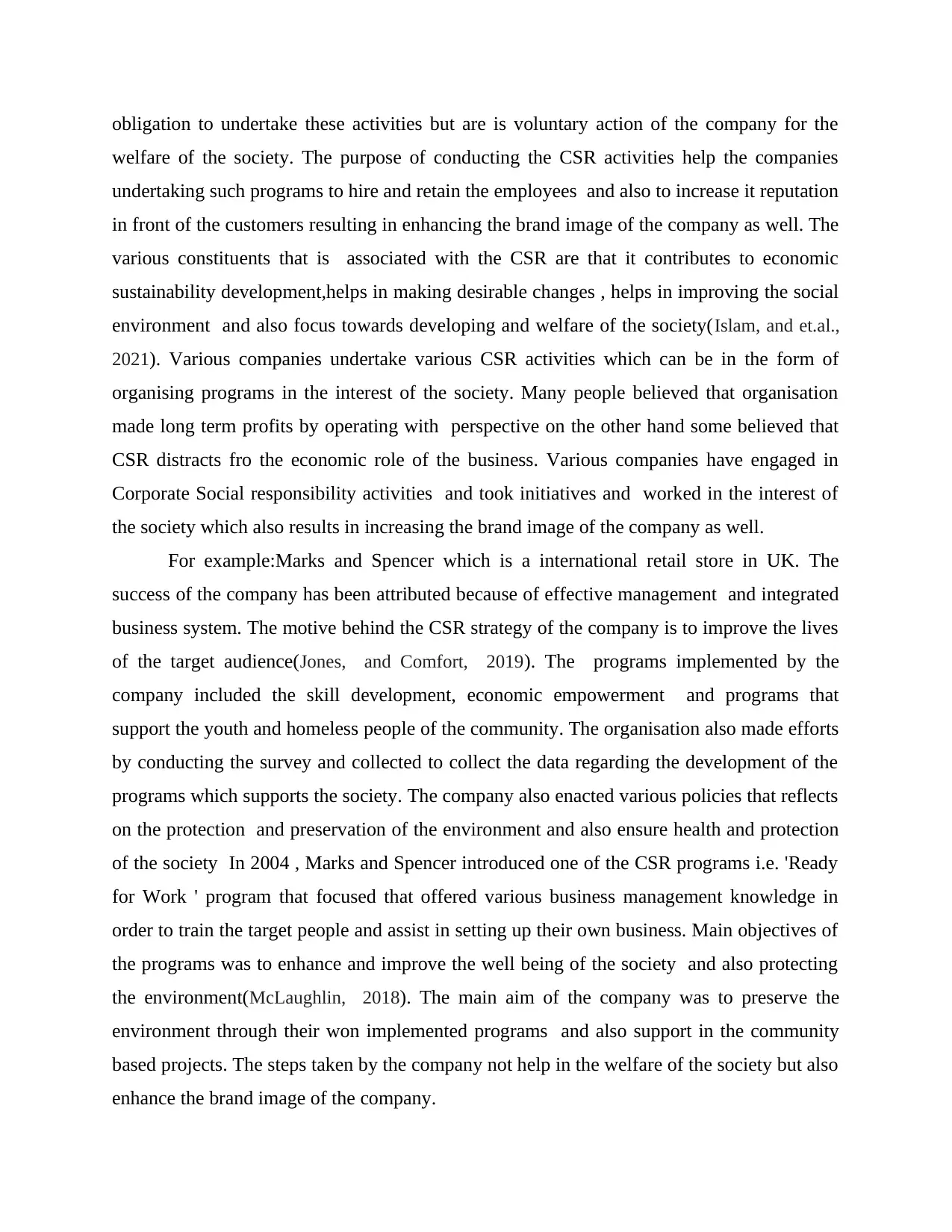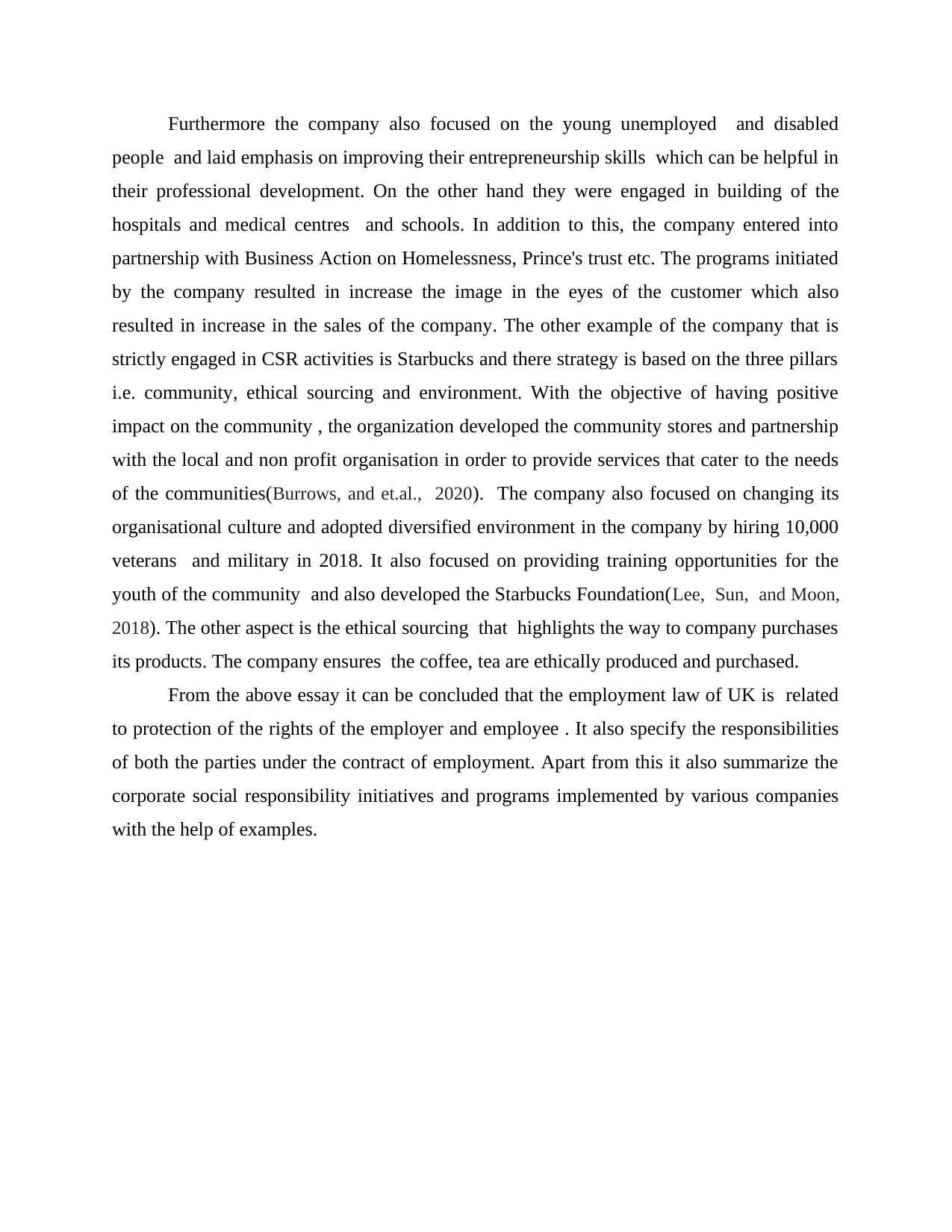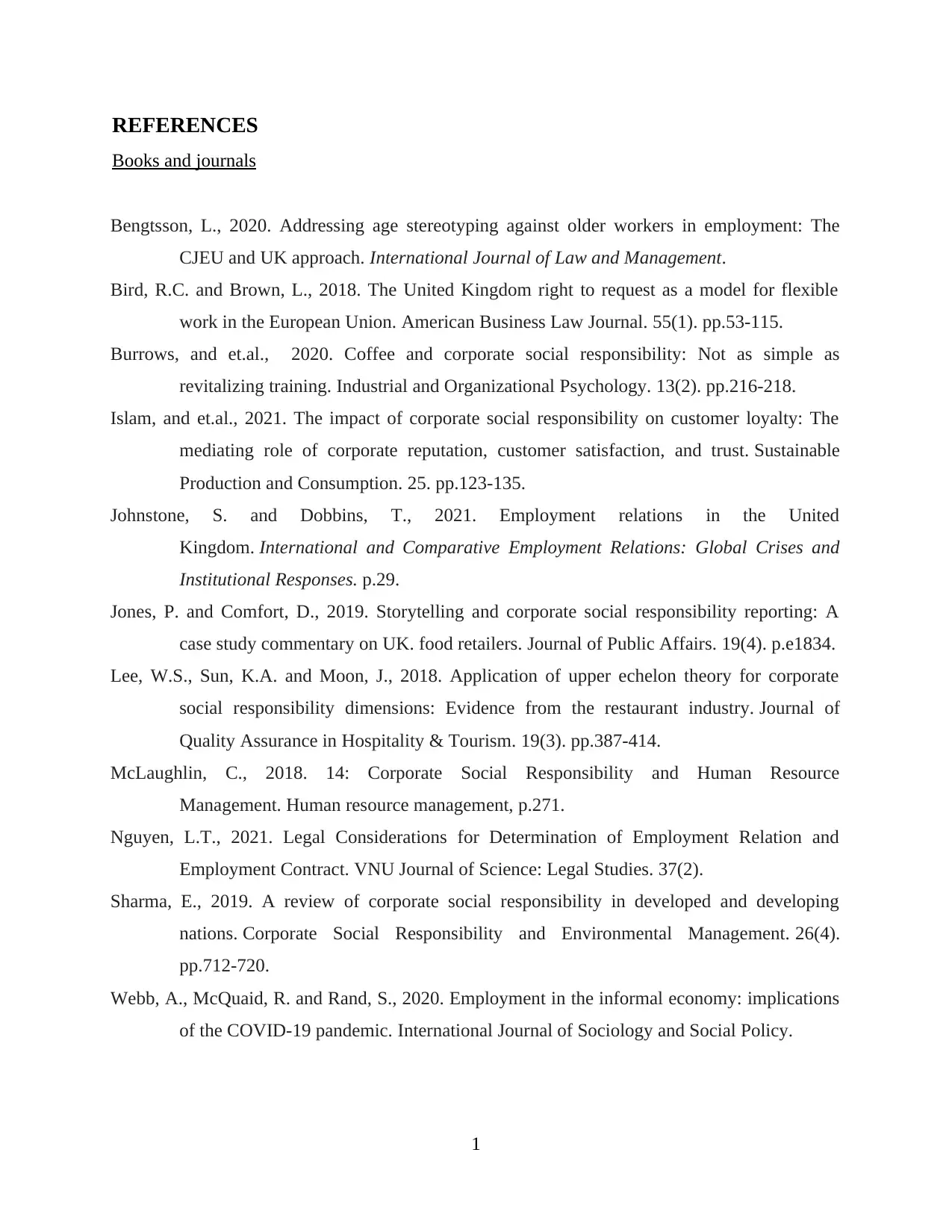Employment Law and CSR: A UK Perspective on Business Practices
VerifiedAdded on 2023/06/10
|8
|2110
|482
Essay
AI Summary
This essay provides a comprehensive overview of UK employment law and corporate social responsibility (CSR). It begins by outlining the key sources of UK employment law, including common law, employment legislation, and European law, and discusses the role of employment tribunals in resolving disputes. The essay then delves into specific aspects of employment law, such as the Equal Pay Act, health and safety regulations, and disability discrimination laws, emphasizing the protection of employee rights and the responsibilities of employers. Furthermore, the essay explores the concept of CSR, defining it as a self-regulating business model that promotes social accountability. It examines how CSR initiatives benefit both society and the company's brand image. The essay provides examples of companies like Marks & Spencer and Starbucks, highlighting their CSR programs and their impact on communities and employees. The essay concludes by summarizing the key takeaways regarding the balance between employment law, employee rights, and the implementation of CSR initiatives in the UK business environment.

Business Law and Ethics
Paraphrase This Document
Need a fresh take? Get an instant paraphrase of this document with our AI Paraphraser

Table of Contents
ESSAY.............................................................................................................................................3
REFERENCES................................................................................................................................1
ESSAY.............................................................................................................................................3
REFERENCES................................................................................................................................1

ESSAY
This essay is based on the Employment Law and Corporate Social Responsibility and the
present writing covers the structure of Employment law of UK and it related provisions
initiatives taken by the organisation regarding the Corporate social responsibility. It also includes
various programs that is implemented by the company for the welfare of the society.
Employment law of UK is derived from three main sources i.e. Common Law,
Employment legislation and tribunals and European law. It has been studies that majority of the
disputes that arise between the employer and employee are heard by the employment tribunals.
The employment tribunal consist of set of rules and regulations that is different from the
provisions of the civil courts(Bengtsson, 2020). During the transition period of Brexit some of
the provisions that was applicable but soon after its completion ended on 31 December. There
has been various changes in the UK employment law over the time period and the provisions
has made from strict and provides wider protection to the employees and their rights. The
employment law includes: Equal pay act 1970, Heath and safety at work act 1974, Disability
discrimination act 1995 etc. Regarding the employment tribunals there are specialist employment
courts that deals with the disputes that arise in the course of employment (Johnstone, and
Dobbins, 2021). The cases is generally related to the violation of the rights of the employee and
misconduct of the employer. The other is the common law courts in which if the employee of the
company who wishes to bring contractual claim against the employer can seek to either high
court or supreme for redress. The third is the government body called the ACAS Arbitration
scheme which helps in providing that are cost effective alternatives for the employment
tribunals. The employment law ensures protection of the rights of both the employer and
employee. Under this act a contract of employment is prepared and takes place between the
employer and employees which specifies all the terms and condition and also regarding the rights
and responsibilities under the contract of employment. The contract of employment also states
the provisions regarding the breach of contract and liability for such breach by any party to the
contract.
This law states while recruiting the employer will not discriminate and also ensures that
no inequality and discrimination practices is being followed by the company(Nguyen, 2021).
The act also highlights various the rights and responsibilities of both employer and employee
towards each other and company. It is the responsibility of the employer to ensure that the health
This essay is based on the Employment Law and Corporate Social Responsibility and the
present writing covers the structure of Employment law of UK and it related provisions
initiatives taken by the organisation regarding the Corporate social responsibility. It also includes
various programs that is implemented by the company for the welfare of the society.
Employment law of UK is derived from three main sources i.e. Common Law,
Employment legislation and tribunals and European law. It has been studies that majority of the
disputes that arise between the employer and employee are heard by the employment tribunals.
The employment tribunal consist of set of rules and regulations that is different from the
provisions of the civil courts(Bengtsson, 2020). During the transition period of Brexit some of
the provisions that was applicable but soon after its completion ended on 31 December. There
has been various changes in the UK employment law over the time period and the provisions
has made from strict and provides wider protection to the employees and their rights. The
employment law includes: Equal pay act 1970, Heath and safety at work act 1974, Disability
discrimination act 1995 etc. Regarding the employment tribunals there are specialist employment
courts that deals with the disputes that arise in the course of employment (Johnstone, and
Dobbins, 2021). The cases is generally related to the violation of the rights of the employee and
misconduct of the employer. The other is the common law courts in which if the employee of the
company who wishes to bring contractual claim against the employer can seek to either high
court or supreme for redress. The third is the government body called the ACAS Arbitration
scheme which helps in providing that are cost effective alternatives for the employment
tribunals. The employment law ensures protection of the rights of both the employer and
employee. Under this act a contract of employment is prepared and takes place between the
employer and employees which specifies all the terms and condition and also regarding the rights
and responsibilities under the contract of employment. The contract of employment also states
the provisions regarding the breach of contract and liability for such breach by any party to the
contract.
This law states while recruiting the employer will not discriminate and also ensures that
no inequality and discrimination practices is being followed by the company(Nguyen, 2021).
The act also highlights various the rights and responsibilities of both employer and employee
towards each other and company. It is the responsibility of the employer to ensure that the health
⊘ This is a preview!⊘
Do you want full access?
Subscribe today to unlock all pages.

Trusted by 1+ million students worldwide

and safety of the employer by providing them with the employee benefit and appreciate for the
hard work which encourages the workers to put more efforts and contribute in the achievement
of the organisational goals.
From the various studies it is revealed that the employment law favours and consider only
about the welfare of employee rather than employers. The employment law only specifies the
rights and duties of the employer and employee and if any case comes before the tribunal and
they listen to both the parties and after being heard and considering and evaluating the evidence
the court gives their judgements. But most of the provisions of the employment law favours the
rights of the employee as it is the duty of the employer to to ensure about the rights of the
employees and ensure their safety and on the other hand it also states that if any misconduct is
done on the part of employer , they are liable to reach to the tribunal and are liable for
compensation for their misconduct(Bird, and Brown, 2018). The laws have been made more
strict in relation to the protection of the rights of the employee in the company.
The laws are introduced by the company in order to protect the rights of both the parties
in the contract of employment but lays more emphasis on the employer and their duties towards
the employer as they are considered as valuable assets of the company and contributes in the
achievement of the organisational goals with the help of their skills and knowledge. The
employee is liable for the compensation in case the employer breaches any terms that is
specifically mentioned under the contract of employment(Webb, McQuaid, and Rand, 2020).
On the other hand the current provisions of the employment act has been modified which
highlights the change sin the rights of the employer. Thus with the help of the employment act,
employer can reach to the court and justice is served as a result of any misconduct on the part of
employer under this act and also specifies the amount that is to be paid by the company to the
employees.
Corporate social responsibility is one of the self regulating business model that
enable the company be be socially accountable and undertakes the activity that is in the
interest of the society and also affects the reputation of the business. Furthermore, the CSR
initiatives taken by the company benefits both the society and also help in building the brand
image of the company(Sharma, 2019). The initiatives and programs related to CSR is one of
the ways to increase the morale of the employee at workplace. The company is not under the
hard work which encourages the workers to put more efforts and contribute in the achievement
of the organisational goals.
From the various studies it is revealed that the employment law favours and consider only
about the welfare of employee rather than employers. The employment law only specifies the
rights and duties of the employer and employee and if any case comes before the tribunal and
they listen to both the parties and after being heard and considering and evaluating the evidence
the court gives their judgements. But most of the provisions of the employment law favours the
rights of the employee as it is the duty of the employer to to ensure about the rights of the
employees and ensure their safety and on the other hand it also states that if any misconduct is
done on the part of employer , they are liable to reach to the tribunal and are liable for
compensation for their misconduct(Bird, and Brown, 2018). The laws have been made more
strict in relation to the protection of the rights of the employee in the company.
The laws are introduced by the company in order to protect the rights of both the parties
in the contract of employment but lays more emphasis on the employer and their duties towards
the employer as they are considered as valuable assets of the company and contributes in the
achievement of the organisational goals with the help of their skills and knowledge. The
employee is liable for the compensation in case the employer breaches any terms that is
specifically mentioned under the contract of employment(Webb, McQuaid, and Rand, 2020).
On the other hand the current provisions of the employment act has been modified which
highlights the change sin the rights of the employer. Thus with the help of the employment act,
employer can reach to the court and justice is served as a result of any misconduct on the part of
employer under this act and also specifies the amount that is to be paid by the company to the
employees.
Corporate social responsibility is one of the self regulating business model that
enable the company be be socially accountable and undertakes the activity that is in the
interest of the society and also affects the reputation of the business. Furthermore, the CSR
initiatives taken by the company benefits both the society and also help in building the brand
image of the company(Sharma, 2019). The initiatives and programs related to CSR is one of
the ways to increase the morale of the employee at workplace. The company is not under the
Paraphrase This Document
Need a fresh take? Get an instant paraphrase of this document with our AI Paraphraser

obligation to undertake these activities but are is voluntary action of the company for the
welfare of the society. The purpose of conducting the CSR activities help the companies
undertaking such programs to hire and retain the employees and also to increase it reputation
in front of the customers resulting in enhancing the brand image of the company as well. The
various constituents that is associated with the CSR are that it contributes to economic
sustainability development,helps in making desirable changes , helps in improving the social
environment and also focus towards developing and welfare of the society(Islam, and et.al.,
2021). Various companies undertake various CSR activities which can be in the form of
organising programs in the interest of the society. Many people believed that organisation
made long term profits by operating with perspective on the other hand some believed that
CSR distracts fro the economic role of the business. Various companies have engaged in
Corporate Social responsibility activities and took initiatives and worked in the interest of
the society which also results in increasing the brand image of the company as well.
For example:Marks and Spencer which is a international retail store in UK. The
success of the company has been attributed because of effective management and integrated
business system. The motive behind the CSR strategy of the company is to improve the lives
of the target audience(Jones, and Comfort, 2019). The programs implemented by the
company included the skill development, economic empowerment and programs that
support the youth and homeless people of the community. The organisation also made efforts
by conducting the survey and collected to collect the data regarding the development of the
programs which supports the society. The company also enacted various policies that reflects
on the protection and preservation of the environment and also ensure health and protection
of the society In 2004 , Marks and Spencer introduced one of the CSR programs i.e. 'Ready
for Work ' program that focused that offered various business management knowledge in
order to train the target people and assist in setting up their own business. Main objectives of
the programs was to enhance and improve the well being of the society and also protecting
the environment(McLaughlin, 2018). The main aim of the company was to preserve the
environment through their won implemented programs and also support in the community
based projects. The steps taken by the company not help in the welfare of the society but also
enhance the brand image of the company.
welfare of the society. The purpose of conducting the CSR activities help the companies
undertaking such programs to hire and retain the employees and also to increase it reputation
in front of the customers resulting in enhancing the brand image of the company as well. The
various constituents that is associated with the CSR are that it contributes to economic
sustainability development,helps in making desirable changes , helps in improving the social
environment and also focus towards developing and welfare of the society(Islam, and et.al.,
2021). Various companies undertake various CSR activities which can be in the form of
organising programs in the interest of the society. Many people believed that organisation
made long term profits by operating with perspective on the other hand some believed that
CSR distracts fro the economic role of the business. Various companies have engaged in
Corporate Social responsibility activities and took initiatives and worked in the interest of
the society which also results in increasing the brand image of the company as well.
For example:Marks and Spencer which is a international retail store in UK. The
success of the company has been attributed because of effective management and integrated
business system. The motive behind the CSR strategy of the company is to improve the lives
of the target audience(Jones, and Comfort, 2019). The programs implemented by the
company included the skill development, economic empowerment and programs that
support the youth and homeless people of the community. The organisation also made efforts
by conducting the survey and collected to collect the data regarding the development of the
programs which supports the society. The company also enacted various policies that reflects
on the protection and preservation of the environment and also ensure health and protection
of the society In 2004 , Marks and Spencer introduced one of the CSR programs i.e. 'Ready
for Work ' program that focused that offered various business management knowledge in
order to train the target people and assist in setting up their own business. Main objectives of
the programs was to enhance and improve the well being of the society and also protecting
the environment(McLaughlin, 2018). The main aim of the company was to preserve the
environment through their won implemented programs and also support in the community
based projects. The steps taken by the company not help in the welfare of the society but also
enhance the brand image of the company.

Furthermore the company also focused on the young unemployed and disabled
people and laid emphasis on improving their entrepreneurship skills which can be helpful in
their professional development. On the other hand they were engaged in building of the
hospitals and medical centres and schools. In addition to this, the company entered into
partnership with Business Action on Homelessness, Prince's trust etc. The programs initiated
by the company resulted in increase the image in the eyes of the customer which also
resulted in increase in the sales of the company. The other example of the company that is
strictly engaged in CSR activities is Starbucks and there strategy is based on the three pillars
i.e. community, ethical sourcing and environment. With the objective of having positive
impact on the community , the organization developed the community stores and partnership
with the local and non profit organisation in order to provide services that cater to the needs
of the communities(Burrows, and et.al., 2020). The company also focused on changing its
organisational culture and adopted diversified environment in the company by hiring 10,000
veterans and military in 2018. It also focused on providing training opportunities for the
youth of the community and also developed the Starbucks Foundation(Lee, Sun, and Moon,
2018). The other aspect is the ethical sourcing that highlights the way to company purchases
its products. The company ensures the coffee, tea are ethically produced and purchased.
From the above essay it can be concluded that the employment law of UK is related
to protection of the rights of the employer and employee . It also specify the responsibilities
of both the parties under the contract of employment. Apart from this it also summarize the
corporate social responsibility initiatives and programs implemented by various companies
with the help of examples.
people and laid emphasis on improving their entrepreneurship skills which can be helpful in
their professional development. On the other hand they were engaged in building of the
hospitals and medical centres and schools. In addition to this, the company entered into
partnership with Business Action on Homelessness, Prince's trust etc. The programs initiated
by the company resulted in increase the image in the eyes of the customer which also
resulted in increase in the sales of the company. The other example of the company that is
strictly engaged in CSR activities is Starbucks and there strategy is based on the three pillars
i.e. community, ethical sourcing and environment. With the objective of having positive
impact on the community , the organization developed the community stores and partnership
with the local and non profit organisation in order to provide services that cater to the needs
of the communities(Burrows, and et.al., 2020). The company also focused on changing its
organisational culture and adopted diversified environment in the company by hiring 10,000
veterans and military in 2018. It also focused on providing training opportunities for the
youth of the community and also developed the Starbucks Foundation(Lee, Sun, and Moon,
2018). The other aspect is the ethical sourcing that highlights the way to company purchases
its products. The company ensures the coffee, tea are ethically produced and purchased.
From the above essay it can be concluded that the employment law of UK is related
to protection of the rights of the employer and employee . It also specify the responsibilities
of both the parties under the contract of employment. Apart from this it also summarize the
corporate social responsibility initiatives and programs implemented by various companies
with the help of examples.
⊘ This is a preview!⊘
Do you want full access?
Subscribe today to unlock all pages.

Trusted by 1+ million students worldwide

REFERENCES
Books and journals
Bengtsson, L., 2020. Addressing age stereotyping against older workers in employment: The
CJEU and UK approach. International Journal of Law and Management.
Bird, R.C. and Brown, L., 2018. The United Kingdom right to request as a model for flexible
work in the European Union. American Business Law Journal. 55(1). pp.53-115.
Burrows, and et.al., 2020. Coffee and corporate social responsibility: Not as simple as
revitalizing training. Industrial and Organizational Psychology. 13(2). pp.216-218.
Islam, and et.al., 2021. The impact of corporate social responsibility on customer loyalty: The
mediating role of corporate reputation, customer satisfaction, and trust. Sustainable
Production and Consumption. 25. pp.123-135.
Johnstone, S. and Dobbins, T., 2021. Employment relations in the United
Kingdom. International and Comparative Employment Relations: Global Crises and
Institutional Responses. p.29.
Jones, P. and Comfort, D., 2019. Storytelling and corporate social responsibility reporting: A
case study commentary on UK. food retailers. Journal of Public Affairs. 19(4). p.e1834.
Lee, W.S., Sun, K.A. and Moon, J., 2018. Application of upper echelon theory for corporate
social responsibility dimensions: Evidence from the restaurant industry. Journal of
Quality Assurance in Hospitality & Tourism. 19(3). pp.387-414.
McLaughlin, C., 2018. 14: Corporate Social Responsibility and Human Resource
Management. Human resource management, p.271.
Nguyen, L.T., 2021. Legal Considerations for Determination of Employment Relation and
Employment Contract. VNU Journal of Science: Legal Studies. 37(2).
Sharma, E., 2019. A review of corporate social responsibility in developed and developing
nations. Corporate Social Responsibility and Environmental Management. 26(4).
pp.712-720.
Webb, A., McQuaid, R. and Rand, S., 2020. Employment in the informal economy: implications
of the COVID-19 pandemic. International Journal of Sociology and Social Policy.
1
Books and journals
Bengtsson, L., 2020. Addressing age stereotyping against older workers in employment: The
CJEU and UK approach. International Journal of Law and Management.
Bird, R.C. and Brown, L., 2018. The United Kingdom right to request as a model for flexible
work in the European Union. American Business Law Journal. 55(1). pp.53-115.
Burrows, and et.al., 2020. Coffee and corporate social responsibility: Not as simple as
revitalizing training. Industrial and Organizational Psychology. 13(2). pp.216-218.
Islam, and et.al., 2021. The impact of corporate social responsibility on customer loyalty: The
mediating role of corporate reputation, customer satisfaction, and trust. Sustainable
Production and Consumption. 25. pp.123-135.
Johnstone, S. and Dobbins, T., 2021. Employment relations in the United
Kingdom. International and Comparative Employment Relations: Global Crises and
Institutional Responses. p.29.
Jones, P. and Comfort, D., 2019. Storytelling and corporate social responsibility reporting: A
case study commentary on UK. food retailers. Journal of Public Affairs. 19(4). p.e1834.
Lee, W.S., Sun, K.A. and Moon, J., 2018. Application of upper echelon theory for corporate
social responsibility dimensions: Evidence from the restaurant industry. Journal of
Quality Assurance in Hospitality & Tourism. 19(3). pp.387-414.
McLaughlin, C., 2018. 14: Corporate Social Responsibility and Human Resource
Management. Human resource management, p.271.
Nguyen, L.T., 2021. Legal Considerations for Determination of Employment Relation and
Employment Contract. VNU Journal of Science: Legal Studies. 37(2).
Sharma, E., 2019. A review of corporate social responsibility in developed and developing
nations. Corporate Social Responsibility and Environmental Management. 26(4).
pp.712-720.
Webb, A., McQuaid, R. and Rand, S., 2020. Employment in the informal economy: implications
of the COVID-19 pandemic. International Journal of Sociology and Social Policy.
1
Paraphrase This Document
Need a fresh take? Get an instant paraphrase of this document with our AI Paraphraser

2
1 out of 8